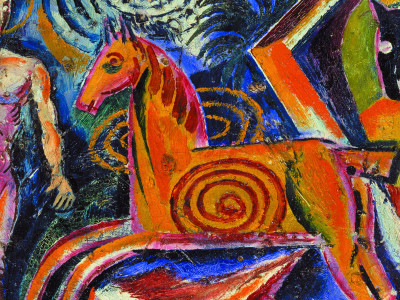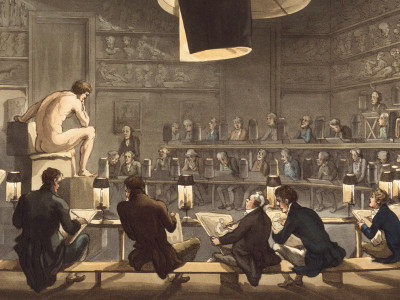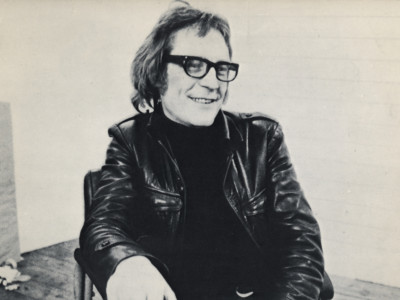
Frank Bowling: the artist who put abstraction on the map
By Simon Wilson
Published on 4 June 2019
The British-Guyanese artist spent decades in New York at the forefront of experimental abstract painting. Now, at age 85, he's finally celebrated in a retrospective show at Tate Britain. We trace how he got there.
From the Summer 2019 issue of RA Magazine, issued quarterly to Friends of the RA.
Frank Bowling RA is the maker of some of the most ravishingly coloured, and later almost ludicrously luscious, of all the works of what became broadly known as Colour Field painting, a movement he found himself at the burgeoning heart of when he moved from London to New York in 1966. But the intense sensuousness of his painting always has an underpinning of thought.
One aspect of his thinking has concerned the nature of painting itself, a hot topic in the New York avant-garde in which he arrived. But also important was the presence in his paintings, for a time, of a certain ghostly but significant imagery relating to his geographical and ethnic background. His critical and theoretical writings on these matters were published in the prestigious Arts Magazine, where he became a contributing editor.
When Bowling left London he disappeared off the radar of the British art establishment, notably that of the Tate Gallery, and this continued after he returned to London in 1975. The first painting by him entered the Tate collection in 1987. Now, in 2019, at the age of 85, he is being given a sumptuous retrospective at Tate Britain.

It is true that until fairly recently Bowling was perhaps hard to place in the dominant curatorial narratives of art since the 1960s. Born in British Guiana (now Guyana), he came to London at the age of 19. His initial ambition was to be a poet and writer, but in 1959 he won a scholarship to the Royal College of Art. There he found himself among the Hockney generation, soon to make their mark with Pop. Bowling graduated in 1962, winning the Silver Medal for painting. The Gold went to Hockney, but apparently only after intense debate.
Bowling at once began to attract attention. His work of this period, fascinatingly revealed in the Tate show, while figurative, drew on very different imagery from the commercial and popular culture of the Pop painters. Very different too was his style, strongly influenced by Francis Bacon. The result was a highly personal synthesis, as was noted at the time. The critic Andrew Forge wrote, "Bowling has subjects of his own to measure up to the style: birth, monsters, mirrors, surgeons, beautiful girls on ornate sofas, himself as Othello." This work chimed perfectly with the existential mood of much post-war European and British art. But times were changing and Bowling was in tune with the zeitgeist. It can be seen in those early works that Bowling the abstract colourist is already present. This, and the realisation that the world focus of art had changed, led him to New York and large-scale abstract painting.

In New York, Bowling developed complex methods of producing huge fields of apparently stained or washed colours of great subtlety and beauty, and even almost hallucinatory effect. In the Tate catalogue they are described as "otherwordly". I am tempted to add, visionary. Underlying these fields however were faintly discernible outlines of the continents of the world. These "Map Paintings" provide a key to the significance of Bowling’s mature oeuvre: his art, however "otherwordly", is anchored in some way in the world. In later, richly encrusted, almost bejewelled canvases, the titles often invite us to make the connections.
Bowling’s long career makes me think of that comment of Jesus on his reception in his home town of Nazareth, "A prophet is not without honour, except in his own country". Bowling’s reputation in America was established by a solo show at the Whitney in 1971 and his ensuing friendship with the great American critic Clement Greenberg. But in the end his heart lay in London and eventually London did open its arms to him. First up was the RA, which elected him a Member in 2005. In 2008 he was appointed OBE.
Now comes that ultimate accolade, the Tate retrospective. And I have to say that, judging from my advanced view of the catalogue, they have done him proud. The selection is both art-historically lucid and of sometimes breathtaking beauty. Equally important is the catalogue’s series of essays, which enable us to see the true nature of Bowling’s art and its intellectual underpinnings. The book establishes the significance of Bowling’s contribution, in both theory and practice, to a significant current in the art of his time. Compliments to the curators. All is forgiven!
Frank Bowling is at Tate Britain, London, from 31 May to 26 August 2019.
Simon Wilson is a columnist for RA Magazine and a former Tate curator.

Frank Bowling in his own words
Ahead of his Tate retrospective, Frank Bowling sat down with us to reflect on his 85 years of life, art, and lessons learnt along the way.
Related articles

Visions from Ukraine
19 June 2024

10 RA Schools stories through the centuries
16 May 2024

In memoriam: Mick Moon RA
1 May 2024